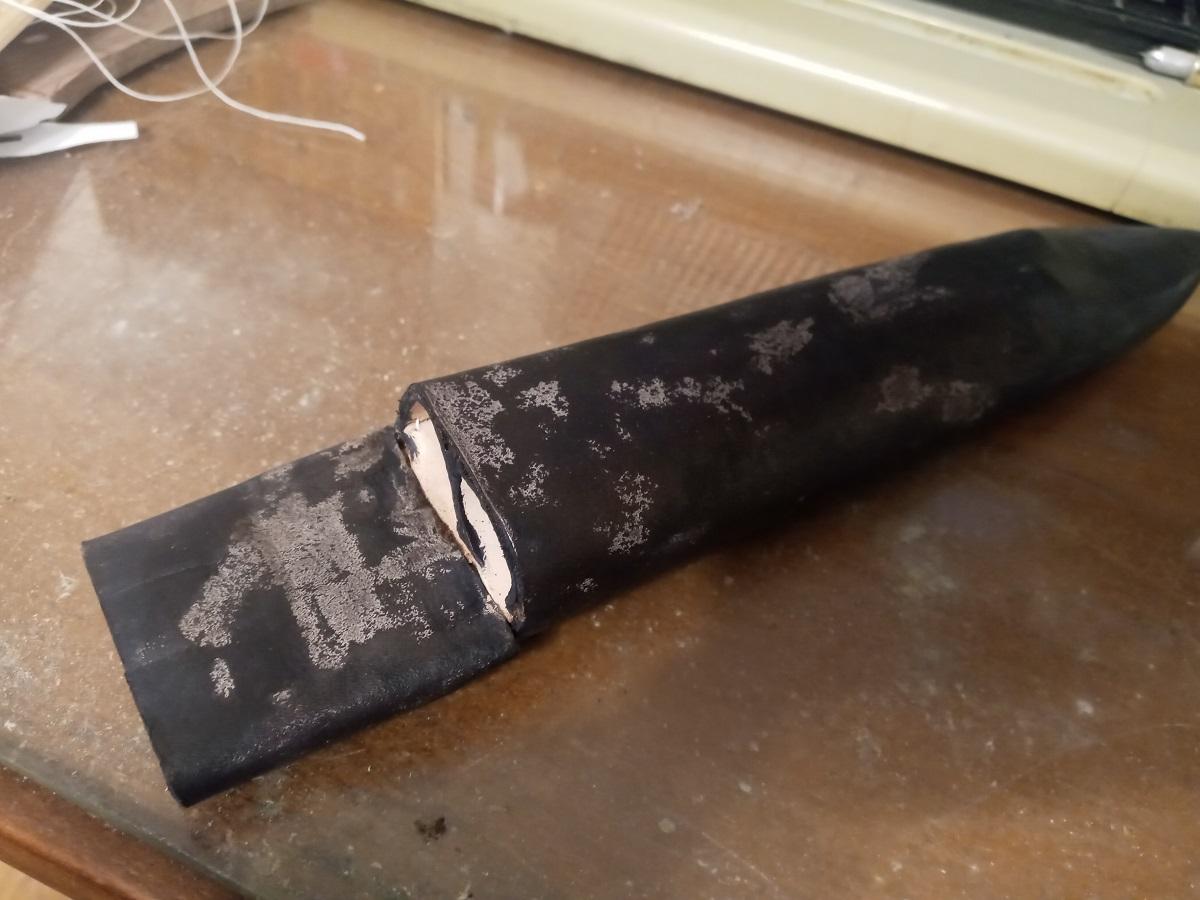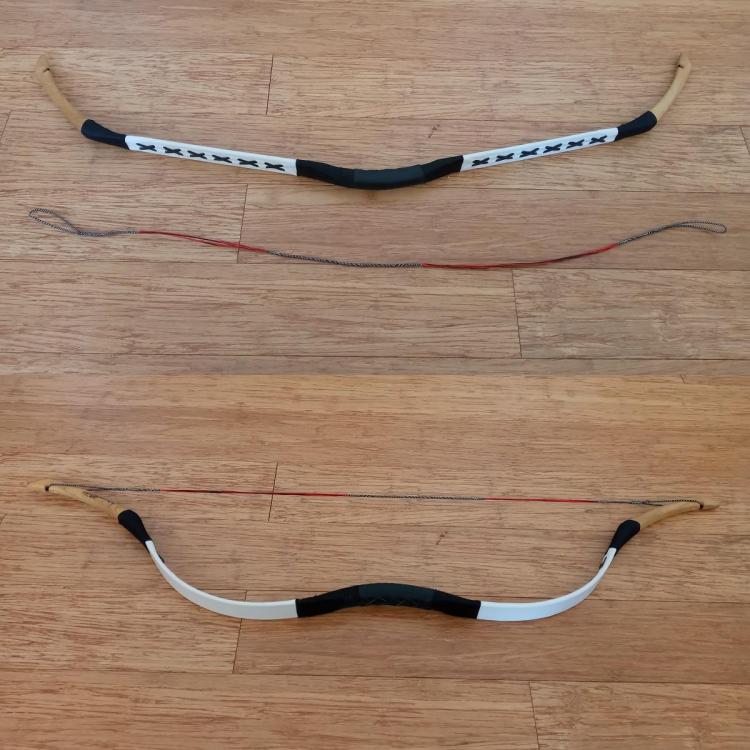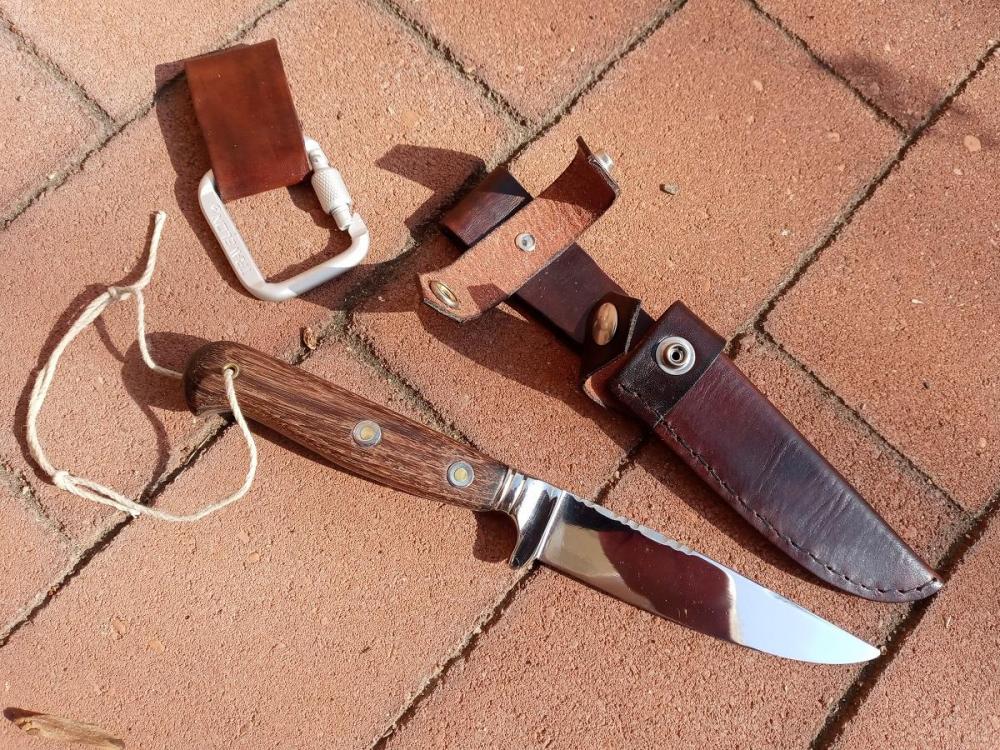
DanDSilva
Members-
Posts
37 -
Joined
-
Last visited
Content Type
Profiles
Forums
Events
Blogs
Gallery
Everything posted by DanDSilva
-
Interesting. The reason I tried it with hide glue was on the advice of several people who say they've used it for similar projects -- one suggest it for a two-layer leather scabbard and another for adhering the facing to a wood core with side leather pockets. I've used it before myself, but not in cases where I'd then dye it -- one was a rawhide facing on a wooden shield which I then sealed with oil paint, and another was a pre-dyed chrome-tan facing on a wood scabbard core, which I applied dry. After thinking it over I'm beginning to lean toward the glue getting out through the openings in the facing for the side pockets and getting smudged as I stitched the facing. The fact that I applied the facing wet probably didn't help. I'll look for a gum eraser, but if I can't get one I'll just dye and dye again.
-
Hello again, I recently constructed a sheath for an antique-style hunting cleaver with a by-knife and fork in side pockets. The main sheath, side pockets and facing are all thin, molded veg-tan, with a small amount of Titebond hide glue to hold the facing in place. This is the first time I've built a sheath like this. I just dyed it this afternoon and found that in certain areas the dye was patchy. I suspect these are areas where the glue either soaked through or got onto the outside. Is this likely to be the problem? If so, is there anything I can do about it at this point? Thanks very much for any advice.
-
Oh hey, I found it! https://www.ccsutlery.com/store/saber-belt-brass-stud.html It turns out I hadn't seen how they're installed in the straps from the back and didn't realize they're actually double-ended, buttoned through both the front and back of the strap, rather than riveted or screwed in place like a modern leather button.
-
Huh. I've been using belt rivets for 15 years and it somehow never came to my attention that they're supposed to be used with a setter. Thanks!
-
I mean, the shanks are tapered just toward the ends, the burrs don't fit down past the taper, and on all the rivets I can easily get, the length of shank that's not tapered is at least 2mm too long to snugly hold two 2mm layers. So I'd have to either taper the shank further down, or widen the burr holes (which is also something I'd prefer to avoid if reasonably possible).
-
Hello everyone, I'm looking for belt rivets (the kind with burrs, not the threaded kind) for two layers of 2mm thick leather. The smallest ones in the local store are listed as 3/8" and are 2mm too long, so I guess I'm looking for ones that are as close as possible to 19/64". I'm not at all confident that 1/4" ones would work. I know it should be possible to shorten and re-taper the shanks of 3/8" ones, but I figured it couldn't hurt to ask before doing something that tedious.
-
From what I'm finding, it appears that tarpaulins normally use snap buttons.
-
I'll take a look, thanks.
-
I have, but their largest ones look to be too small and not the right shape.
-
Hello again. I'm looking for very wide-headed buttons for a 19th-century sword belt. There are some photos here. I've seen replicas of these sorts of belts with this sort of button sold online, but so far I haven't been able to dig up a source for just the buttons. Right now I have the idea of grinding the top halves off the heads of regular Sam Browne-type buttons so there's the maximum possible flat surface, and soldering brass discs on, but I figure wide-headed ones that were actually made as such would look better, not be at risk of solder failing, and save me the trouble. Has anyone seen them for sale?
-
Hello, I recently came across this thread discussing making a brush-on dye which begins by boiling some Salicornia in the water before adding the dyestuffs and other ingredients. I'd really like to try it. All the ingredients are readily available and not too expensive except for the Salicornia itself, which it seems I can only get from specialty online food stores that charge quite a bit in shipping because it's a fresh vegetable. I was wondering if anyone could explain or at least speculate on what purpose the plant serves in the dye and whether it would be possible to substitute anything for it. I know it's alkaline and high in salt, but I don't know if either of those is what's important; plants contain so many different substances. I have tried contacting the OP but since he hasn't been active outside of that one thread and it was seven years ago, I don't really expect an answer.
-
Milling is a pretty common technique, so there are probably lots of cowhides from different makers that look like that. If you don't want to gamble on one that might not turn out to be to your liking, maybe bring a scrap back to the store you got it from and ask who made it or if they plan to restock it.
-
Dyeing a bow
DanDSilva replied to DanDSilva's topic in Dyes, Antiques, Stains, Glues, Waxes, Finishes and Conditioners.
Well, I thank you for your thoughts, but as mentioned, I really doubt I'd be able to redo the string wrapping correctly. Suppose for the time being that it's stuck with the leather the maker put on it. -
Dyeing a bow
DanDSilva replied to DanDSilva's topic in Dyes, Antiques, Stains, Glues, Waxes, Finishes and Conditioners.
It's a 25lb. Ali Bow Mini Han. I got it for historical battle reenactment because I wanted the smallest bow possible so the belt-mounted bowcase wouldn't be too much of an encumbrance while running around (the type of bowcase for my historical period is relatively large and heavy, with a thick wooden spine). I agree removing the leather would be a good idea, but it's bound by the string at the bridges and grip and I've never done that kind of fine string wrapping -- even if I got good instructions and succeeded at redoing it, it'd probably look sloppy. Painting may be a good idea if I can keep it neat and be fairly sure it won't flake. Otherwise, I could write to the company and ask if they'd be willing to divulge any information about the leather -- though I'd guess they just buy it prefinished and don't worry too much about the exact processes or finishes used as long as it's the right color, texture and weight. -
This is sort of an odd situation and I wouldn't like to be in it, but here goes: I bought a bow recently. Due to a misunderstanding I wound up with one covered in white leather instead of tan; the company is overseas and I didn't think it was worth the time or shipping charges to exchange it. I'd like to dye it tan so it doesn't call attention to itself like it does now. I have on hand Fiebings water-based saddle tan, Leather Sheen and Resolene. The leather seems to be lambskin or a very thin, fine cowhide, and feels chrome-tanned. There aren't really any inconspicuous spots to test-dye. The bow itself is fiberglass with wooden siyahs and what look to be synthetic string bridges. Given the above, should I 1) not bother and just use it as it is because it's not likely to take dye or getting it wet could damage it, 2) use the dye I have now and seal it with either the Leather Sheen or Resolene, or 3) order a different dye and/or sealer?
-
It's made of 4-5 ounce veg-tan, dyed with Fiebing's Pro dark brown, finished with Resolene, neatsfoot oil and Sno-Seal, and stitched with nylon artificial sinew. The rivets are nickel-plated brass and the snaps are stainless line 20 line snaps from Tandy. If I were doing this again, I might consider doing the finish after stitching, because the Resolene stiffened the leather quite a lot and I didn't like the sort of tearing sound the awl made when going through the leather. Also would make the welt and distance between the stitching and the very edge at least half again wider, maybe more. This is the first time I've set line snaps and they were a bit tricky. They feel like they'd open up just a bit easier than I'd like for the knife to feel really secure in the sheath.
-
All done. This is what I've wound up with: It's a pretty basic design, copied more-or-less from Puma. I stitched the belt loop to the sheath, but also made a belt dangler with an aluminum screw carabiner. I think that solves the problem nicely.
-
Some chrome-tan is as firm as veg-tan and some is much softer, but I think for a typical, structured messenger bag, the firmness of veg-tan in 5-ounce or slightly lighter would work fine. The main difference AFAIK is that chrome-tan is typically less affected when it gets wet. Personally, unless it had to match some other articles, I wouldn't dye it. An old-fashioned saddle tan from just oil/wax and weathering would look great on a messenger bag. But that's down to personal taste of course.
-
Vegetable-dyeing leather is a bit of a lost art in the English-speaking world. We have older books on the subject, but they are often vague (such as lacking measurements, especially Medieval texts) or use ingredients that are hard to get nowadays. I would think that if you're running a tannery, it would be much easier to contract someone else to grow and/or process your plant dyes rather than try to do both at once. But here are some links you might find useful: Madder (red) The color produced by madder tends to be duller and often more "rusty" than we expect from modern artificial red dyes. Madder Dye Plant Cultivation Red leather using historical dye (madder) Roman Red: dying leather with madder roots Indigo (blue) Judging from most of the photos I've seen, vegetable-tanned leather dyed with indigo tends to be either dull (since the underlying brownish color of the leather clashes with the blue) or dark (if dyed enough times to hide the brown). Though I do remember seeing a pair of fairly bright blue boots once that were supposedly dyed with indigo. Woad is used in much the same way, because the main colorant is the same as found in indigo, though in smaller amounts; it's called indigotin. Growing Indigo This site also has instructions on preparing the dyebath. Dyeing Leather With Indigo. Apparently the process is much the same as with fabric, but you need to soak leather longer and rinse thoroughly to remove the alkali. Unfortunately I have never found clear instructions for producing a good natural yellow on leather. Turmeric produces a wonderful color, which is washfast, but it's not lighfast at all -- a day in the sun will leave it looking like it was never dyed in the first place. I've been frustrated finding out how to use rhamnus (Persian berry or buckthorn), although it was once a popular leather dye, and weld (reseda) is apparently just difficult to use on leather. Here's some further information from another user.
-
Hi, It's good to know. I see I didn't fully explain what I'm trying to accomplish -- my aim isn't only to keep the knife from falling out of the frog by accident, but also that it should be easy to remove without having to take off the belt, so, for instance, you can quickly take it off and lock it in your glove compartment or something if you realize you're going into a building where it wouldn't be permitted (my local community college, for instance, doesn't permit us to wear large knives and I know there'll be others with similar policies). That's why I was looking at a separate frog instead of just a sheath with a built-in belt loop. I've also thought of using an integrated belt loop closed with laces or snaps, or a belt dangler with a square screw carabiner... any of those sound workable?
-
Thank you. I think I'm going to try a few combinations on test swatches. My preference is a dark color from the start since black or dark brown seem to be traditional with this style, but if I can't prevent bleeding, then a deep saddle tan from just oil and wax will have to suffice. By the way, anyone have any thoughts on the sheath and frog combination that Weber offers for this blade? Is it likely to be good and secure against both the knife accidentally popping out of the sheath and the sheath popping out of the frog, or could it use improvement in that regard?
-
Thanks! So, if it's thoroughly buffed, oil dye won't need an acrylic sealer? Very nice. Is the color dyed or just from a large amount of oil?






